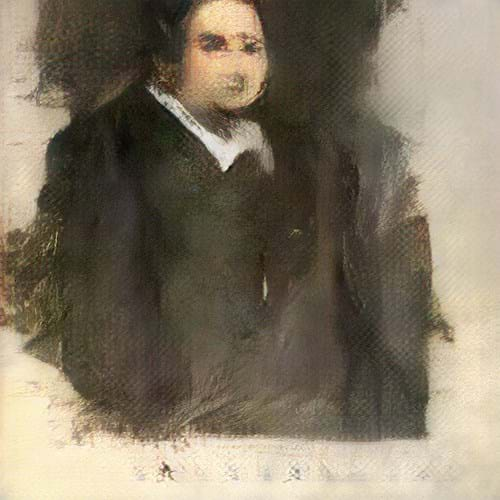
Portrait of Edmond de Belamy is the first painting created solely by artificial intelligence that will be auctioned at a major auction. Christie’s will offer it with a $7000-10,000 estimate in New York in October.
It is one of 11 unique works in a series called ‘La Famille de Belamy’ conceived by the Paris-based AI collective Obvious.
As with the other works in the series, the image appears unfinished with blank areas of the canvas and indistinct facial features. It would appear the algorithm has yet to convince art critics that it can replicate human creativity but Obvious will use proceeds from the sale towards further research and to finance the computation power needed to produce this type of artwork.
“Not the product of a human mind”
The work measures 23.5in (60cm) square and is printed on canvas. Known as a ‘Generative Adversarial Network’ print, Christie’s described it as “not the product of a human mind”.
It was created by an algorithm composed of two parts. The first part (the ‘generator’) was fed a data set of 15,000 portraits from Old Masters to Modern paintings and created new images based on this input. The second part (the ‘discriminator’) reviewed all outputs until it deemed the result imperceptible as to whether it was done from a human-hand or not.
While contemporary artists have already been incorporating aspects of artificial intelligence into their work, Christie’s says this offering is different as it is created solely by an algorithm.
It will be offered at Christie’s Prints & Multiples auction in New York on October 23-25.

The portrait at Christie’s created by the Paris-based collective Obvious. Proceeds from the sale will be used to further the collective’s research into training its algorithm and to finance the computation power needed to produce this type of artwork. Image: Christie’s.
The Obvious collective consists of Hugo Caselles-Dupré, Pierre Fautrel and Gauthier Vernier.
Caselles-Dupré said: “Most of all, we want the viewer to focus on the creative process: an algorithm usually functions by replicating human behaviour, but it learns by using a path of its own.”
Christie’s international head of prints and multiples Richard Lloyd said: “Christie’s continually stays attuned to changes in the art market and how technology can impact the creation and consumption of art. AI has already been incorporated as a tool by contemporary artists and as this technology further develops, we are excited to participate in these continued conversations.”





